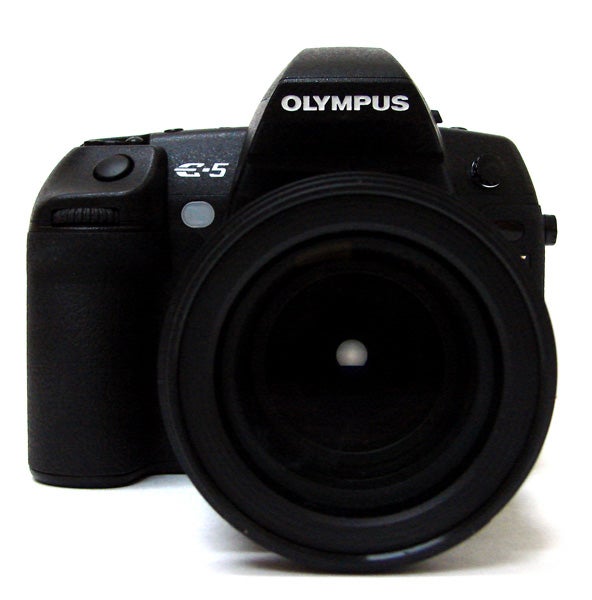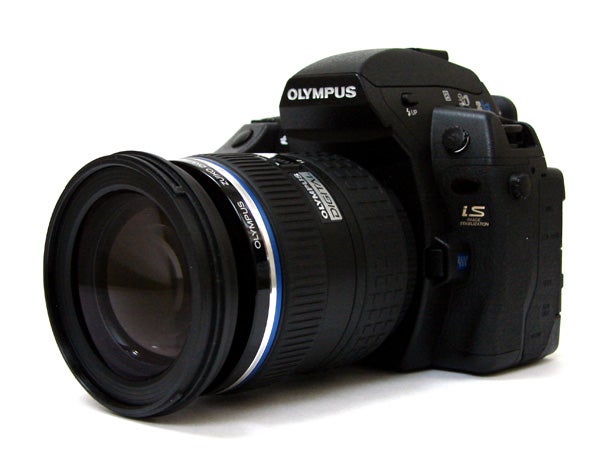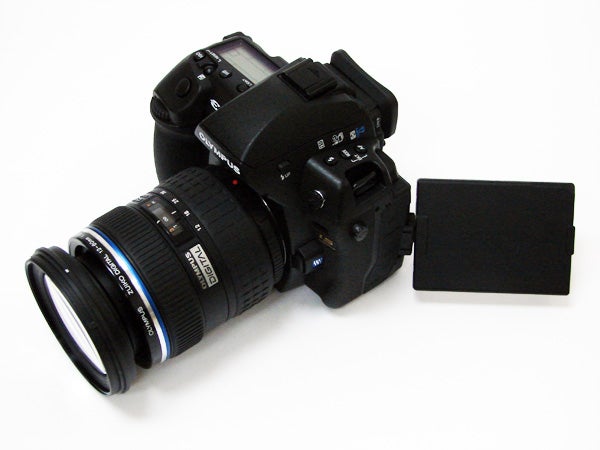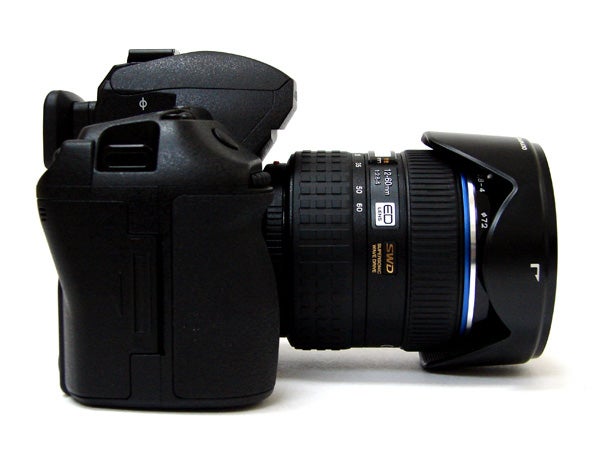Olympus E-5 Review
Olympus E-5
Olympus' new flagship E-5 digital SLR has a semi professional build and feature set. So, how does it stack up against rivals, and could this really be its maker's last ever DSLR?

Verdict
Key Specifications
- Review Price: £1379.95
Way back in 2002, Olympus’ original E-1 camera was the first digital SLR to be constructed as a digital camera from the ground floor up, competing models from Canon, Nikon, Pentax et al having been devised based on existing 35mm film camera bodies. 
The result was, said Olympus, that its rivals were bulkier in almost every respect than they needed to be. Olympus’ alternative plan was instead to fully embrace this new digital technology, suggesting that its E series range, which made use of what it referred to as a Four Thirds sensor – smaller in dimension to the APS-C sized sensors commonly used in rival DSLRs – was the way forward.
This Four Thirds (also written 4/3rds) system would enable smaller camera bodies and lenses that truly played to digital photography’s strengths. Proof of the pudding could be witnessed in the fact that a 14-42mm Four Thirds system lens provided the equivalent of 28-84mm 35mm film lens – so, in other words, double the focal length.
Whilst that initial model and its successors were indeed marginally smaller than the fledgling digital SLRs of the time, nearly a decade later the latest E-5 iteration (updating the competent E-3, having seemingly skipped a generation) is still just as chunky as the likes of Nikon’s D7000 and Canon’s EOS 60D. At 800g in weight, body only, in fact it’s a bit of a doorstop. 
As well as considering what rivals have to offer when weighing up whether the E-5 is the DSLR for you, it’s also worth noting what’s going on with Olympus itself at the moment. The manufacturer appears to be pinning most (if not all) of its hopes – and future development funds – on the even smaller (mirror-less) Micro Four Thirds system cameras, which include the CES announced Olympus Digital Pen E-PL2. Accompanying the E-5’s release, there have been heavy suggestions from the company therefore that this could be its last digital SLR proper.
So is the range-topping E-5 a fitting swan song, the last gasp of a series that has apparently had its day, or… is there enough new and of interest here to suggest that an obituary might be a little premature?
Certainly the E-5’s 12.3 megapixel headline resolution feels modest when stacked up against rivals in its manufacturer’s suggested £1,500 body-only price bracket, which may further put off anyone thinking of buying into this system from scratch. That said, Olympus has included a TruePic V+ image processing engine which, among other things, is claimed to provide enhanced detail over cameras with larger sensors. The DSLR’s chief target audience is most likely existing E-3 owners, tempted to upgrade by the E-5’s expanded feature set arriving a couple of years down the line.
The E-5’s build as much as feature set lends it semi professional status. Olympus supplied our test sample with a weighty, stunningly sharp and inevitably expensive piece of glass in the wide angle 12-60mm zoom lens, providing an all-encompassing 24-120mm equivalent reach, enabling us to shoot a (literally) wide variety of subject matter.
The body’s solidity is such that it not only feels like it could stop a bullet when gripped, but also comes with a weather-proofed moisture and dust resistant magnesium alloy body, to take on nearly all climates and inclement conditions. We also get two media card slots, as on Nikon’s D7000, located beneath a sliding catch tucked just behind the handgrip. Here’s it’s a choice of SD, SDHC and, additionally, newer high capacity SDXC plus the more traditional CompactFlash, type I and II. 
Another new feature of this model is the ability to record 1280×720 (HD Ready) video clips, at 30 frames per second. A dedicated record button is provided marked with the symbol of an old-fashioned movie camera, though filming will only begin with a thumb press once Live View mode – the means by which the eponymous reflex mirror lifts up, disabling the optical viewfinder, and allowing you to view the live image on the rear LCD – has first been selected. The screen then provides a cropped 16:9 ratio image to more closely resemble the footage that’s being recorded (otherwise it’s a 4:3 ratio aspect image). HDMI and regular AV outputs are provided for piping the footage straight out to a TV while USB2.0 output is there to connect to a computer. Live View likewise handily has its own button top right of the screen, so you don’t have to delve into the menu systems to otherwise enable either.
Which brings us to what the E-5 most visibly misses that is a traditional bottle-top style shooting mode dial, an omission that feels slightly odd at first if coming to the camera fresh from a competing brand. Instead there’s merely a tiny compact-camera style ‘mode’ button located on the left hand side of the top plate, the relevant letter (P for Program for example) of whichever mode is in play at the time appearing in the top plate display window when pressed. It’s a system that works once you get used to it, but we do prefer the tactile (and less fiddly) option of a chunky dial.
As on Canon’s EOS 60D, the E-5 provides the compositional advantage of a tilt and swivel LCD with Live View, something we felt was an omission on the Nikon D7000. For those low or high angle shots where it’s not always possible to get an eye level with the optical viewfinder, this proved a definite boon to us, and once you’ve used a camera with this facility it’s hard to go back to a fixed screen. Here the screen can either be flipped outward or turned to face inwards to the body for added protection when in transit. It’s also useful in that, with a resolution of a high 920k dots, its clarity is sufficient to allow manual focus to be checked with greater efficiency than when using the smaller optical viewfinder above, even if it does otherwise offer 100% field of view.
The same display window, or top-plate LCD, is flanked by four attendant buttons for, variously, illuminating the display, adjusting white balance, exposure and ISO with a button press and twist of either front or rear plate command dials, whilst a combined press of the latter two buttons will reset the camera’s functions. A glance down at the top screen will confirm at any time which mode is currently in play, without the need to otherwise inspect such information on the back plate LCD and divert the lens away from pointing directly at your intended subject.
A feature that we do enjoy, and one which Olympus arguably originated with its E-series DSLRs and had co-opted by its Digital Pens, is that of the integral Art Filter digital effects, applied to an image at the point of capture. This is of great use to those who are wishing for more visual oomph than the rather flat scene before them might provide – but without having to spend ages in Photoshop to achieve similar afterwards. Perhaps a little odd to feature such consumer-level gimmicks on a DSLR that aims for professional status, but they help to further set the range apart from the pack, if only to a limited degree.
Included on the E-5 are a wealth of creative choices, similar to those provided by the Pens by virtue of including our favourites of pop art, pinhole and toy-town-like ‘diorama’ effect, also found as a miniature mode on the latest Canon PowerShot and IXUS cameras. Selected via the same back-screen menu as the above effects are Picture Mode settings which allow further enhancements, such as making colour more muted or saturated. With the default camera setting being ‘natural’, there’s the chance to let the camera choose optimum settings for a given scene by alternatively selecting ‘i-Enhance’ mode, as well as manually selecting monotone or a custom setting.
If Live View has already been chosen on the rear LCD, the effects of these filters are shown pre-capture, so the process becomes less experimental. Since they are then applied at the time of capture, writing times slow slightly, but not prohibitively.
Like previous E-series digital SLRs the E-5 is suitably fast in operation. Startup time is to all intents and purposes instant while up to five frames per second capture is offered in burst shooting mode. The thumb-operated on/off switch is located near the camera’s base, rather than the more familiar setting of a DSLR’s top plate, while the shutter button is in its usual spot where it falls under the forefinger. Spacing is such that both can easily be reached simultaneously so there’s no operational slowdown.
The E-5, as expected at this level, has the ability to shoot Raw files, JPEGs or a combination of both with incremental JPEG compression levels selectable whether shooting individually or in tandem. In auto focus (AF) mode we found that, courtesy of its 11 point AF system, the E-5 locked onto target within a second or so. There’s no dedicated AF/MF switch on lens or camera body but instead a quick twist of the manual focus ring will set manual focussing in motion and allow for fine tuning. In this regard, taking photographs with the E-5 feels particularly intuitive.
The chunky Zuiko Digital ED 12-60mm f/2.8-4.0 Four Thirds system lens we were provided with makes a very able match for the E-5’s sensor, helping to deliver truckloads of detail even when shooting handheld at maximum telephoto and in spite of the camera’s apparently modest headline resolution. Flexibility is such that we were able to achieve some lovely shallow depth of field shots, ideal for portraiture and still life, as well as expansive landscape shots at maximum 24mm equivalent wide angle.
For those who want to shoot in low light and avoid the need to use either the E-5’s built-in pop up flash or accessory flashgun attachable via its vacant hotshoe, the maximum ISO level of 6400 will be something of a disappointment, as will the noisy results you get even at this level. Adjustable in inrements from ISO100 up to ISO6400, it’s really only from ISO800 below that noise is kept in check. True enough, we’re not really reaching ruinous levels until ISO3200 and ISO6400, but there are other candidates out there better suited if low light photography is your thing.
Under daylight conditions the camera and its lens fared rather better with generally sharp results all round. Colours on the E-5’s default ‘natural’ filter setting proved a little muted for our tastes, with Vivid setting delivering to our eyes a result that was closest to the scene at the time, and the ‘i-Enhance option effecting some impressive decisions too, colours being bolder yet more naturalistic than the garish results to be had from otherwise selecting the pop art filter.
The E-5 comes across then as a very capable option for anyone looking for top quality images from a very durable DSLR body who is not already wedded to the systems of the ‘big two’ in Canon and Nikon, though as we mentioned earlier and will do so in our conclusion, there are further caveats to take into account if you really are considering a purchase.
It seems something of a shame that Olympus’ hand may be forced to quit the DSLR market in the near future and concentrate on the burgeoning compact system camera market instead. But, with such great success with its Pen range, including the E-PL2 which we hope to be able to bring you a review of in due course, and massive competition at the high-end of the market from Canon, Nikon and Sony, it’s certainly a sensible business decision.
Ultimately, though, if this is the company’s last DSLR outing, at least it has saved the best until last. It’s well built, easy to use and can produce some great results. Unfortunately, that’s the bare minimum for a high-end DSLR and while there are still plenty of lenses and attachments for the Four Thirds system, we couldn’t in all conscience recommend the E-5 as a system camera you might want to get into from scratch – at least not at its £1,500 launch price. There are simply better options for around £1,000, the Canon 60D and Nikon D7000 both being obvious examples.
If, however, you’re already furnished with a host of compatible lenses and accessories, the E-5 will undoubtedly be a welcome upgrade just as soon as the price drops a bit.

“The following were all shot as Large, Fine quality JPEGs under available natural light, with automatic white balance deployed and the camera set to ‘Natural’ Picture Mode.”
—-
Showing the full frame with ISO set to Auto, the camera has correctly ascertained ISO200 as being up to the task.
—-
The same framing at ISO100 and no noise to report. Nice colours too.
—-
Same shot at ISO200 and similarly no image noise to report.
—-
We’re at ISO400 and some very subtle image noise is creeping in.
—-
ISO800 and there’s noise, but again hardly at a noticeable level.
—-
Things are taking a turn for the worse at ISO1600, so avoid this setting if you want to avoid noise levels appearing incrementally worse.
—-
Noise is visible across the entire frame at ISO3200.
—-
And looking distinctly gritty in appearance at ISO6400, so this is one to avoid unless you are deliberately aiming for a grainy look and feel.
“A more general selection of test shots are revealed on this page and next to act as an evaluation of the E-5 in a variety of shooting conditions with the 12-60mm (24-120mm equivalent) zoom lens on test attached.”
—-

Up close and personal with our test lens to give a narrow depth of field but maintain detail where it matters, thus drawing the eye in.
—-

By contrast a wider scene taken with the E-5 and supplied 12-60mm lens that displays softening of detail towards the corners. Plus also some pixel fringing where the branches of the tree are framed against a featureless sky top right hand of frame – even though such artefacts are only visible on particularly close scrutiny.
—-
By contrast again, a shot taken handheld with the lens at the extreme telephoto end of the zoom, detail sufficient to pick up the subtle pattern of the duck’s feathers.
“Here are some general test shots taken with the E-5 and 12-60mm lens as stated to give an idea of performance ability when it comes to image quality, dynamic range, colour rendition and the lens’ focal range.”
—-

This stag picture was taken hand held utilising the telephoto end of the zoom in the last available light of the day and, apart from a slight boost in contrast, is the image as delivered by the camera. Deploying the i-Enhance function tends to produce warmer, more flattering images than the camera’s default ‘natural’ setting.
—-

A lovely shallow depth of field here in this close up E-5 image with again an enticingly warm colour tone delivered by the camera, and plenty of detail in evidence for a ‘mere’ 12MP model.
—-


By way of a direct comparison, here area couple of maximum wide angle images from the E-5 which have not been altered in any way, showing the difference between Natural Picture mode and the warmer tones delivered by selecting i-Enhance instead. The actual colours of the scene at the time fell somewhere between the two.
Trusted Score
Score in detail
-
Value 7
-
Image Quality 9
Features
| Camera type | Micro Four Thirds |
| Megapixels (Megapixel) | 12.3 Megapixel |
| Optical Zoom (Times) | N/Ax |
| Image Sensor | 13.1 megapixel Four Thirds Live Mos sensor |
| Optical focal length | Dependent on lens in use |
| Shutter speed | 1/8000-60 secs |
| Auto focus | TTL phase difference detection system (11 AF points) |
| Manual focus | Yes |
| Max output resolution | 4032x3024 |
| Other resolutions | 3200x2400, 2560x1920, 1600x1200, 1280x960, 1024x768, 640x480 |
| Focus range | Dependent on lens in use |
| Exposure control | P, A, S, M |
| Exposure metering | ESP light metering, spot, centre weighted, highlight, shadow |
| Exposure compensation | 1, 1/2, 1/3 steps, +/- 5EV |
| Image Stabilisation | Sensor shift (vertical or horizontal activation) |
| ISO settings | Auto, 100 to 6400 |
| LCD Monitor | 3-inch, 920k dot resolution |
| Viewfinder | Optical, eye level pentaprism type |
| Flash range | Guide number 13 (ISO100) |
| Flash modes | Auto, Manual, Red eye reduction, Slow Sync with red-eye reduction, Slow sync, 2nd curtain and slow sync, Fill-in flash |
| White balance modes | Auto, overcast, shade, tungsten, sunlight, 3x flourescent settings |
| Drive modes | Single, continuous |
| Image formats | Raw, JPEG |
| Picture adjustments | Dramatic, Grainy, Pin hole, Pop Art, Soft Focus, Pale, Light, Sepia, Diorama, Cross Process |
| Video (max res/format) | 1280 x 720 at 30fps |
| Movie length | Up to 2GB or 14 minutes standard definition, 7 minutes HD |
| Self timer | 12, 2 secs |
| Memory card slot | SD/SDHC/SDXC and Compact Flash |
| Supplied memory | N/A |
| Batteries supplied | Lithium ion battery pack |
| Charger supplied | Yes |
| A/V output | Yes |
| Charging/Computer Connection | USB 2.0 |
| HDMI | HDMI |
| AV Out | Yes |
| Manual | Basic printed guide, full manual on CD |
Physical Specifications
| Dimensions Width (Millimeter) | 142.5mm |
| Depth (Millimeter) | 116.5mm |
| Weight (body only) (Kilogram) | 800gkg |

